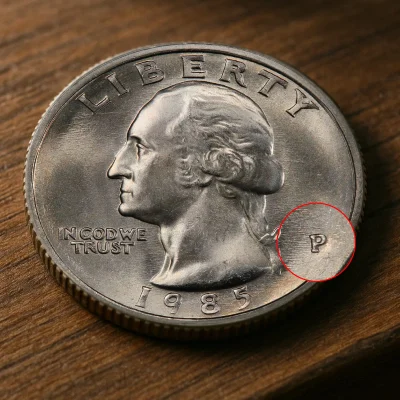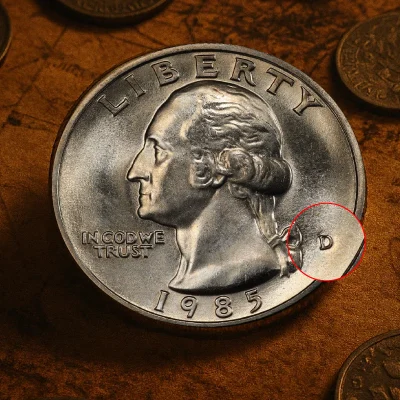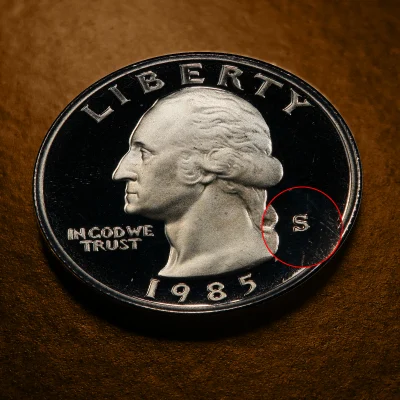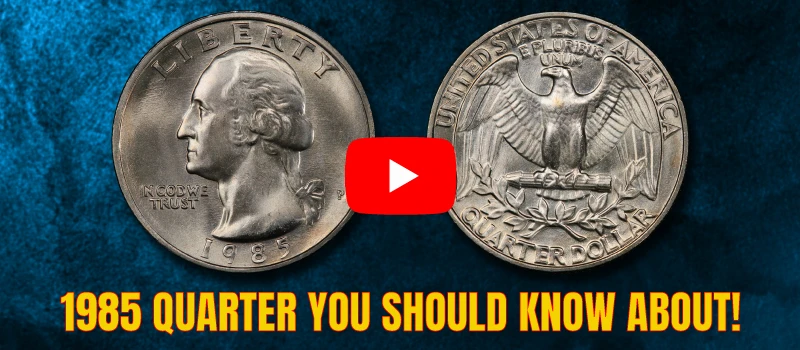Though the Washington quarter of 1985 appears to be just like any other coin
of common change, it holds a secret: hidden among the billions minted are rare
varieties and mistakes for which dealers will pay an arm and a leg, from a few
dollars to a staggering six figures. If you've ever wondered whether that
forgotten quarter in your pocket is worth more than its face value of 25
cents, then you've come to the right location.
This is the ultimate guide to the value of the 1985 quarter. We will cover all
the nitty-gritty—all the way from its composition and mint mark variations to
the place that coin grading serves and a closer examination of the particular,
high-dollar miscuts you will be on the lookout for.
Key Takeaways: 1985 Quarter Value at a Glance
Though the Washington quarter of 1985 appears to be just like any other coin
of common change, it holds a secret: hidden among the billions minted are rare
varieties and mistakes for which dealers will pay an arm and a leg, from a few
dollars to a staggering six figures. If you've ever wondered whether that
forgotten quarter in your pocket is worth more than its face value of 25
cents, then you've come to the right location.
This is the ultimate guide to the value of the 1985 quarter. We will cover all
the nitty-gritty—all the way from its composition and mint mark variations to
the place that coin grading serves and a closer examination of the particular,
high-dollar miscuts you will be on the lookout for.
Key Takeaways: 1985 Quarter Value at a Glance
| 1985-P Quarter |
25 cents |
$2 - $450+ |
The most common value is in the top grade. |
| 1985-D Quarter |
25 cents |
$2 - $400+ |
High mintage; value requires high grade. |
| 1985-S Proof Quarter |
Collector Coin |
$3 - $125+ |
"S" mint mark; mirror-like finish. |
| 1985 DDO Error |
$25 - $100+ |
$300 - $600+ |
Doubling on "IN GOD WE TRUST". |
| Major Errors |
$10 - $1,000+ |
$10 - $1,000+ |
Off-centers, broadstrikes, etc. |
Understanding the Foundation—Coin Composition and
Grading
To accurately value your coin, you must first understand what it is made of
and how its condition is judged.
Is the 1985 Quarter Silver?
Let's clear this up right away: No, the 1985 quarter is not silver. All
Washington quarters produced for circulation since 1965 are a "clad"
composition.
-
Construction: A central copper core covered
between two layers of 75% copper, 25% nickel alloy.
-
Significance: The worth is not in the metal but
is purely numismatic, i.e., based on condition and rarity as judged by
collectors.
The Critical Importance of Grading
The "grade," or state, of a coin is the most critical consideration in
assigning value to it. The Sheldon Scale (1 to 70) quantifies it.
-
Worn: Circulation-worn coins (grades G-4 to
AU-58). A 1985 quarter in this grade will generally be worth face value
unless it's an error.
-
Mint State (MS): Never circulated and with no
wear. MS-60 is not circulated but has numerous marks. MS-65 (Gem) is the
benchmark of a good coin to have. MS-67 is extremely rare and very
expensive.
-
Proof (PR): Specimen coin with a mirror-like
finish. Its ideal grade is PR-70.
The Mint Mark Decoded—P, D, and S Varieties
The little letter on the front (obverse) of your coin, to the right of
Washington's ponytail, is the mint mark. It informs you where the coin was
manufactured and matters for its valuation.
1985-P Quarter Value (Philadelphia)

With a staggering mintage of 585,547,424, the 1985-P is very common.
-
In circulation: 25 cents face value.
-
Uncirculated: A typical uncirculated coin
will sell for $2-$4, but the grade causes the price to skyrocket. An
MS-65 will bring $15-$22. An MS-67, which is extremely rare, can fetch
$450 to $600.
1985-D Quarter Value (Denver)

Also struck in large numbers (521,809,629 mintage), the 1985-D also has a
similar pattern of worth.
-
In circulation: Worth 25 cents.
-
Uncirculated: Almost identical to 1985-P
values. Condition makes all the difference. An MS-65 sells for
$15-$22, but an MS-67 condition specimen is a real find, with prices
between $300 and $500.
1985-S Quarter Value (San Francisco)

This is the one to seek. The "S" mint mark means a proof coin that was
made just for collectors.
-
Standard Proofs: Most 1985-S quarters are in
mint condition. The standard grade is PR-69 and is valued from $3-$7.
-
"Deep Cameo" (DCAM) Proofs: They are sharp
proofs with a beautiful, icy-looking design that is a dramatic
contrast to the mirror background. A PR-69 DCAM is superior, at a
price of $15-$25.
-
The Perfect PR-70 DCAM: The holy grail of a
proof collector is the ultimate reward. Coins graded this perfectly
can retail between $75 to $125 or more.
The Ultimate Treasure Hunt - High-Value 1985 Quarter
Errors

This is where the life-changing worth lies. Mint errors create scarce forms
that are in high demand. Look over your coins through a 5x or 10x magnifier
for these.
The Famous 1985 Doubled Die Obverse (DDO)
It is the most recognized 1985 quarter error. It is not simple machine
doubling; it is a simple die defect.
-
What to See: Single, clear, and distinct
doubling of the letters in "IN GOD WE TRUST" and "LIBERTY".
-
Value: This is a significant find. A circulated
DDO can command $25-$100. Value increases to $300-$600 in Mint State, with
better-quality specimens commanding higher prices.
Off-Center Strikes
The coin was off-center when it was minted, resulting in an off-center
appearance.
-
What to Look For: An abnormal crescent-shaped
blank space on the coin's side.
-
Value: A small 5-10% off-center strike is valued
at $15-$30. A stunning 50% off-center strike, where the date and mint mark
are still legible, is a treasure that is valued at $100 or more.
The $132,000 Error: Struck on a 1964 Dime Planchet
This is legend stuff. A very odd mistake took place when a 1985-D quarter was
accidentally struck on an unused 90% silver planchet from a 1964 Roosevelt
dime.
-
How to Identify It: You'd be very unlikely to
find another, and it would be significantly smaller, more slender, and
lighter than a standard quarter and would be silver in construction.
-
Value: The only documented specimen,
PCGS-graded, sold for a staggering $132,000 at auction to become the
world's most valuable 1985 quarter.
Other Valuable Errors to Find:
-
Broadstrike: A coin struck off of its retaining
collar and thus abnormally thin and broad. Value: $10-$25.
-
Clipped Planchet: A crescent-shaped piece
missing from the edge of the coin, a flaw caused while punching the blank.
Value: $5-$20.
-
Struck-Through: An object (such as wire or
cloth) was struck into the face of the coin and left an impression. Value:
$10-$100+, depending upon the object.
Frequently Asked Questions
1. How Much is a Standard 1985 Quarter Worth?
A circulated 1985 quarter that lacks a 'P' or 'D' mint mark is only worth face
value at 25 cents. Its value only rises if it is in mint, uncirculated form or
if it is an error coin and is uncommon.
2. Is my 1985 Quarter Made of Silver?
No. All quarters minted for circulation in 1985 were copper-nickel clad coins.
The U.S. Mint discontinued using silver in circulating quarters in 1964.
3. What makes a 1985 Quarter Valuable?
Three primary factors: 1) Exceptional Condition: In a very high uncirculated
grade (MS-65 or higher). 2) Proof Issue: Being an "S" mint mark proof coin,
particularly with "Deep Cameo" contrast. 3) Mint Errors: Having an error that
is verifiable, such as the very valuable Doubled Die Obverse (DDO).
4. My 1985 Quarter has no Mint Mark. Is it Rare?
A 1985 quarter with no noticeable mint mark is a coin from the Philadelphia
Mint. Philadelphia in 1985 produced a "P" mint mark. If you can't find it,
then probably it is a 1985-P when the mark was weakly impressed or worn off.
It is not rare.
5. What is the Most Valuable 1985 Quarter Error?
The best-known and most valuable error to seek out is the 1985 Doubled Die
Obverse (DDO), which is worth many hundreds of dollars and more. The
best-known rare error is the 1985-D quarter error incorrectly stamped on a
1964 silver dime planchet and being sold for $132,000.
6. Should I Clean my 1985 Quarter?
No! Cleaning a collectible coin will permanently disfigure its surface, take
away its original mint brilliance, and greatly decrease its value.
Numismatists consider cleaned coins to be damaged goods.
7. What should I do if I Find a Valuable 1985 Quarter?
Handle it carefully by the edges to avoid fingerprints. To confirm its value
and make it easier to sell, you should have it authenticated and graded by a
reputable third-party grading service like PCGS (Professional Coin Grading
Service) or NGC (Numismatic Guaranty Corporation).
